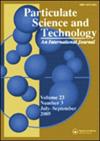Deposition of micron-sized inertial particles on flat surfaces: effects of electrostatic forces and surface roughness
IF 1.5
4区 工程技术
Q3 ENGINEERING, CHEMICAL
引用次数: 0
Abstract
Abstract Micron-sized particles are prone to deposit on smooth surfaces. A micron-sized particle collision-deposition model including the effects of electrostatic forces, integrated with the factors of particle size, material properties, elastic–plastic deformation, particle charging, surface roughness, and van der Waals forces, is proposed. The effects of the electrostatic forces on the critical deposition velocity, collision duration, and coefficient of restitution (COR), which is the ratio of particle velocity after and before the collision, are investigated for 1–20 μm sand particles colliding with glass, steel, and aluminum alloy surfaces. The results show that the electrostatic forces of sand particles are approximately 106–108 times their gravity and increase the impact duration. Moreover, these forces increase the critical deposition velocity by 2.32–6.89% for the glass surface and decrease the COR by 0.6–3.5% for the three surfaces, while the particle size is below 20 μm and the roughness is 1 nm. The electrostatic forces ranked from the maximum to the minimum are those of the aluminum alloy, steel, and glass surfaces for the same particle size and surface roughness. The developed model can perfect the theory of particle flow and gas-particle two-phase flow.微米级惯性粒子在平面上的沉积:静电力和表面粗糙度的影响
微米级的颗粒容易沉积在光滑的表面上。提出了一种考虑静电力影响的微米级颗粒碰撞-沉积模型,该模型综合考虑了颗粒尺寸、材料性能、弹塑性变形、颗粒充电、表面粗糙度和范德华力等因素。研究了静电作用力对1 ~ 20 μm沙粒与玻璃、钢和铝合金表面碰撞的临界沉积速度、碰撞持续时间和碰撞恢复系数(COR)(碰撞前后颗粒速度之比)的影响。结果表明,砂粒的静电力约为其重力的106 ~ 108倍,并增加了冲击持续时间。当颗粒尺寸小于20 μm,粗糙度为1 nm时,这些作用力使玻璃表面的临界沉积速度提高了2.32 ~ 6.89%,使三种表面的COR降低了0.6 ~ 3.5%。在相同的颗粒大小和表面粗糙度下,铝合金、钢和玻璃表面的静电力从大到小依次为。所建立的模型可以完善颗粒流和气相两相流的理论。
本文章由计算机程序翻译,如有差异,请以英文原文为准。
求助全文
约1分钟内获得全文
求助全文
来源期刊

Particulate Science and Technology
工程技术-工程:化工
CiteScore
4.40
自引率
4.00%
发文量
86
审稿时长
12 months
期刊介绍:
Particulate Science and Technology, an interdisciplinary journal, publishes papers on both fundamental and applied science and technology related to particles and particle systems in size scales from nanometers to millimeters. The journal''s primary focus is to report emerging technologies and advances in different fields of engineering, energy, biomaterials, and pharmaceutical science involving particles, and to bring institutional researchers closer to professionals in industries.
Particulate Science and Technology invites articles reporting original contributions and review papers, in particular critical reviews, that are relevant and timely to the emerging and growing fields of particle and powder technology.
 求助内容:
求助内容: 应助结果提醒方式:
应助结果提醒方式:


